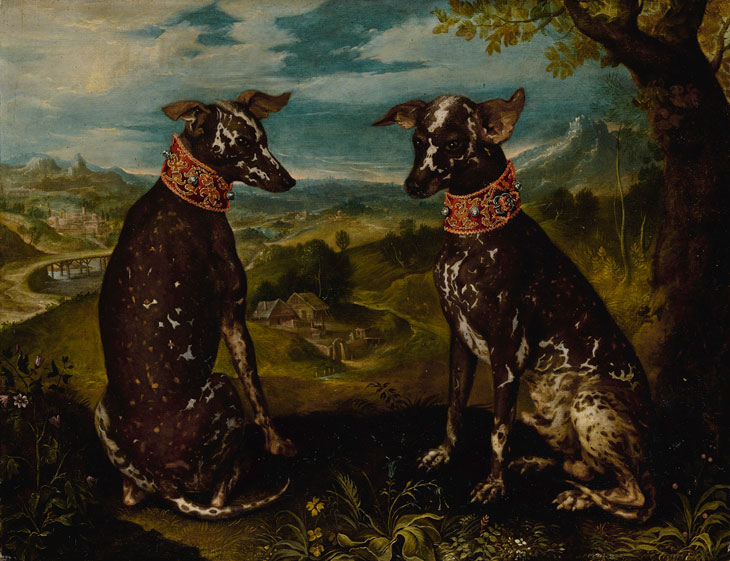Collecting has never been about only the inanimate, as a painting coming to auction at Sotheby’s New York next month bears witness. The work depicts two spectacular Mexican Xoloitzcuintli – or, more likely, a single specimen painted from two viewpoints. Very little is known about the painting or its provenance, but its subject and the milieu which produced it make it arguably the most intriguing object on offer during Masters Week in New York this year.
First, the animal itself. It is a particularly rare spotted version of the Xoloitzcuintli – pronounced show-loh-eets-kweent-lee, or called Xolo for short. The Xolo is one of the oldest recorded breeds of dog in the world, and sacred among the ancient Mesoamerican tribes. For the Aztecs, Xolos served to protect the home and, sacrificed and buried with their owners, would act as humanity’s guide through the Mictlan, the world of death. They were also eaten as part of sacrificial ceremonies. Their defining characteristic, however, is hairlessness.

An exotic dog, the Mexican Xoloitzcuintli (detail; c. 1580–1600), Prague School. © Sotheby’s
One can readily imagine how strange these Xolos appeared to the 16th-century Europeans who first set eyes on them, and their appeal to those early collectors who formed living, outdoor versions of their cabinets of curiosities, otherwise known as menageries. Among the collectors, the Austrian branch of the house of Habsburg was pre-eminent, for its far-reaching empire offered privileged access to the various Iberian ports through which exotic specimens found in the New World and beyond first made their way to Europe. The Sotheby’s catalogue note offers a fascinating glimpse into this sphere of 16th-century trophy hunters and their agents, who procured curiosities living and dead via networks of scouts and merchants. One of the most notable agents was Hans Khevenhüller, Rudolf II’s Imperial Ambassador to Spain – an unlikely job for a modern diplomat.
Unpublished documents and correspondence examined by Dr Annemarie Jordan Gshwend reveal that a Xolo was in fact sent to Rudolf II in Prague (where he established the capital of his empire in 1583) in the 1580s. It may have even been the spotted specimen depicted in the painting coming to auction. Illustrated in the auction house catalogue is another portrait of two extravagantly maned horses with their grooms which seems to have a Xolo in the foreground, possibly the same one. Two Horses and their Grooms (1628) is ascribed by some to the court painter Roelandt Savery, who for around a decade from 1604 produced numerous drawings and paintings of beasts from his master the emperor’s menagerie which he also used in later works.
Just about the only thing certain about the enigmatic painting of the Xoloitzcuintli is that its subject was prized by its owner; his ornate leather and metal collar, as well as the portrait itself, attest to that. It seems likely that this rare early image of a Xolo (more recently, Frida Kahlo, who raised several Xolos, painted hers) will retain its allure for collectors when it comes up for auction on 1 February. Estimate $250,000-$350,000.
The Master Paintings Evening sale takes place at Sotheby’s New York, on 1 February.
Unlimited access from just $16 every 3 months
Subscribe to get unlimited and exclusive access to the top art stories, interviews and exhibition reviews.














![Masterpiece [Re]discovery 2022. Photo: Ben Fisher Photography, courtesy of Masterpiece London](http://zephr.apollo-magazine.com/wp-content/uploads/2022/07/MPL2022_4263.jpg)
Suzanne Treister’s tarot offers humanity a new toolbox